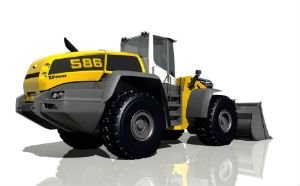Liebherr's power-split transmission wheel loader

Liebherr's new wheel loader has a power-split hydrostatic-mechanical transmission. This new driveline concept has been applied to Liebherr’s largest wheel loader, the L 586, which has a tipping load limit of approximately 20 tonnes.
The continuously variable power-split transmission is a combination of mechanical and hydrostatic drivelines. The diesel engine’s power output is divided between the two sections of the driveline, and recombined where they come together. This principle reduces energy transmission losses and increases efficiency. Liebherr’s transmission and its own electronic control system achieve an additional reduction in power transmission losses.
The electronic transmission control system ensures that the highest practicable ratio is selected and allows the diesel engine to run at a lower speed, which in turn keeps fuel consumption down to a minimum.
The combined effect of the two halves of the transmission is increase practical performance in all stages of the work process. When driven slowly, or when picking up material, the wheel loader is largely driven through the hydrostatic transmission. As speed increases, or during lengthy work cycles, the proportion of power transmitted mechanically increases. Low internal losses in the mechanical driveline are the key to its high efficiency.
The continuously variable transmission has the same functional principle in forward and reverse, so that top speed and efficiency level are identical in either direction.
With this new concept, which it is planned to be adopted for the complete range of large Liebherr wheel loaders, Liebherr has combined the well-proven function of the hydrostatic transmission with the efficiency benefit available from a mechanical driveline. Compared with wheel loaders that have a conventional driveline, Liebherr wheel loaders with the power-split combined hydrostatic and mechanical transmission use less fuel but are none the less capable of higher load handling performance.
Company info
1015 Sutton Drive
Burlington, ON
CA, L7L 5Z8
Website:
liebherr.com/en/can/about-liebherr/liebherr-worldwide/canada/liebherr-in-canada.html


